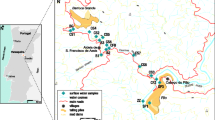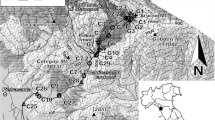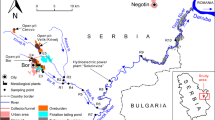Abstract
This study deals with the hydrogeochemical changes and metal(loid) attenuation processes along the extremely acidic Rio Tinto (SW Spain). The geochemistry of Tinto headwaters is determined by the variability of mining discharges due to different geological, geochemical and hydrological controls. Downstream of the mining area, a decrease in most dissolved element concentrations is recorded. However, not all elements decreased its concentration to the same extent, and even some did not decrease (e.g., Ba and Pb). A group of elements formed by Al, Cd, Co, Cr, Cu, Li, Mg, Mn, Ni and Zn behaved quasi-conservatively; mainly affected by dilution, except at the lower part of the catchment where seem to be affected by sorption/coprecipitation (e.g., Cd, Cu, and Zn) or mineral dissolution processes (e.g., Al, Mg). Iron and As exhibited a non-conservative behaviour due to ochre precipitation and sorption processes, respectively. A group of elements formed by Ca, Na, Sr and Li did not behave conservatively; waters were enriched in these elements by dissolutive reactions of carbonates and aluminosilicates from bedrocks. The behaviour of Pb in the Rio Tinto is complex; values fluctuate along the river course and its solubility may be related to the nature of Fe precipitates.








Similar content being viewed by others
References
Accornero, M., Marini, L., Ottonello, G., & Vetuschi Zuccolini, M. (2005). The fate of major constituents and chromium and other trace elements when acid waters from the derelict Libiola mine (Italy) are mixed with stream waters. Applied Geochemistry, 20, 1368–1390.
Acero, P., Ayora, C., Torrento, C., & Nieto, J. M. (2006). The behavior of trace elements during schwertmannite precipitation and subsequent transformation into goethite and jarosite. Geochimica et Cosmochimica Acta, 70, 4130–4139.
Asta, M. P., Ayora, C., Román-Ross, G., Cama, J., Acero, P., Gault, A. G., et al. (2010). Natural attenuation of arsenic in the Tinto Santa Rosa acid stream (Iberian Pyritic Belt, SW Spain): the role of iron precipitates. Chemical Geology, 271, 1–12.
Bencala, K. E., McKnight, D. M., & Zellweger, G. W. (1987). Evaluation of natural tracers in an acidic and metal-rich stream. Water Resources Research, 23, 827–836.
Berger, A. C., Bethke, C. M., & Krumhansl, M. L. (2000). A process model of natural attenuation in drainage from a historic mining district. Applied Geochemistry, 15, 655–666.
Bigham, J. M., Schwertmann, U., Carlson, L., & Murad, E. (1990). A poorly crystallized oxyhydroxysulfate of iron formed by bacterial oxidation of Fe(II) in acid mine waters. Geochimica et Cosmochimica Acta, 54, 2743–2758.
Bigham, J. M., Schwertmann, U., Traina, S. J., Winland, R. L., & Wolf, M. (1996). Schwertmannite and the chemical modeling of iron in acid sulfate waters. Geochimica et Cosmochimica Acta, 60(12), 2111–2121.
Cánovas, C. R., Olias, M., Nieto, J. M., Sarmiento, A. M., & Cerón, J. C. (2007). Hydrogeochemical characteristics of the Odiel and Tinto rivers (SW Spain). Factors controlling metal contents. Science of the Total Environment, 373, 363–382.
Cánovas, C. R., Olías, M., Nieto, J. M., & Galván, L. (2010). Wash-out processes of evaporitic sulfate salts in the Tinto river: hydrogeochemical evolution and environmental impact. Applied Geochemistry, 25(2), 288–301.
Cánovas, C. R., Olías, M., Vázquez-Suñé, E., Ayora, C., & Nieto, J. M. (2012). Influence of releases from a fresh water reservoir on the hydrochemistry of the Tinto River (SW Spain). Science of the Total Environment, 416, 418–428.
Davis, J. C. (1986). Statistics and data analysis in geology. Singapore: Wiley. 646 p.
De la Torre, M. L., Grande, J. A., Graiño, J., Gómez, T., & Cerón, J. C. (2011). Characterization of AMD pollution in the River Tinto (SW Spain). Geochemical comparison between generating source and receiving environment. Water, Air, and Soil Pollution, 216(3), 3–19.
Dzombak, D. A., & Morel, F. M. (1990). Surface complexation modelling: Hydrous ferric oxide. New York: Wiley.
Fernández-Remolar, D. C., Morris, R. V., Gruener, J. E., Amils, R., & Knoll, A. H. (2005). The Río Tinto Basin, Spain: mineralogy, sedimentary geobiology, and implications for interpretation of outcrop rocks at Meridiani Planum, Mars. Earth and Planetary Science Letters, 240, 149–167.
Ferris, F. G., Hallbeck, L., Kennedy, C. B., & Pedersen, K. (2004). Geochemistry of acidic Rio Tinto headwaters and role of bacteria in solid phase metal partitioning. Chemical Geology, 212, 291–300.
Galán, E., Gómez-Ariza, J. L., González, I., Fernández-Caliani, J. C., Morales, E., & Giráldez, I. (2003). Heavy metal partitioning in river sediments severely polluted by acid mine drainage in the Iberian Pyrite Belt. Applied Geochemistry, 18, 409–421.
Grande, J. A., Aroba, J., Andújar, J. M., Gómez, T., De la Torre, M. L., Borrego, J., et al. (2011). Tinto versus Odiel: two AMD polluted rivers and an unresolved issue. An artificial intelligence approach. Water Resources Management, 25(15), 3575–3594.
Gray, N. F. (1998). Acid mine drainage composition and the implications for its impact on lotic systems. Water Research, 32, 2122–2134.
Hubbard, C. G. (2007). Acid mine drainage generation and transport processes in the Tinto River, SW Spain. PhD thesis, University of Reading (UK).
Hudson-Edwards, K. A., Schell, C., & Macklin, M. G. (1999). Mineralogy and geochemistry of alluvium contaminated by metal mining in the Rio Tinto area, southwest Spain. Applied Geochemistry, 14, 1015–1030.
Langmuir, D. (1997). Aqueous environmental geochemistry. Upper Saddle River: Prentice Hall.
Leblanc, M., Morales, J. A., Borrego, J., & Elbaz-Poulichet, F. (2000). 4,500-year-old mining pollution in southwestern Spain: long-term implications for modern mining pollution. Economic Geology, 95, 655–661.
López-Archilla, A. I., & Amils, R. (1999). A comparative ecological study of two acidic rivers in Southwestern Spain. Microbial Ecology, 38(2), 146–156.
Nehlig, P., Cassard, D., & Marcoux, E. (1998). Geometry and genesis of feeder zones of massive sulphide deposits: constraints from the Rio Tinto ore deposit (Spain). Mineralium Deposita, 33, 137–149.
Nocete, F., Alex, E., Nieto, J. M., Sáez, R., & Bayona, M. R. (2005). An archaelogical approach to regional environmental pollution in the south-western Iberian Peninsula related to Third Millenium B.C mining and metallurgy. Journal of Archaeological Science, 32(10), 1566–1576.
Nordstrom, D. K. (1982). The effect of sulfate on aluminum concentrations in natural waters: some stability relations in the system Al2O3–SO3–H2O at 298 K. Geochimica et Cosmochimica Acta, 46(4), 681–692.
Nordstrom, D. K., & Alpers, C. N., (1999). Geochemistry of acid mine waters Chapter 6. In G. S. Plumlee, & M. J. Logsdon (Eds.), The environmental geochemistry of mineral deposits, 1999. Rev. Econ. Geol., Vol. 6A. (pp. 133–160) Soc. Econ. Geol. Inc: Littleton, Colorado.
Nordstrom, D. K., & Wilde, F. D. (1998). Reduction–oxidation potential (electrode method). In: National field manual for the collection of water quality data, U.S. Geological Survey techniques of water-resources investigations, book 9; chapter 6.5.
Olías, M., & Nieto, J. M. (2012). El impacto de la minería en los ríos Tinto y Odiel a lo largo de la historia. Revista de la Sociedad Geológica de España, 25(3–4), 177–192.
Olías, M., Nieto, J. M., Sarmiento, A. M., Cerón, J. C., & Canovas, C. R. (2004). Seasonal water quality variations in a river affected by acid mine drainage: the Odiel river (south west Spain). Science of the Total Environment, 333, 267–281.
Olías, M., Cánovas, C. R., Nieto, J. M., & Sarmiento, A. M. (2006). Evaluation of the dissolved contaminant load transported by the Tinto and Odiel rivers (South West Spain). Applied Geochemistry, 21, 1733–1749.
Olías, M., Nieto, J. M., Sarmiento, A. M., Cánovas, C. R., & Galván, L. (2011). Water quality in the future Alcolea Reservoir (Odiel River, SW Spain): a clear example of inappropriate management of water resources in Spain. Water Resources Management, 25, 201–215.
Parkhurst, D. L., & Appelo, C. A. J. (1999). User’s guide to PHREEQC (Version 2). A computer program for speciation, batch reaction, one-dimensional transport, and inverse geochemical calculations. USGS water-resources investigations report 99-4259. Denver, Colorado.
Pérez-López, R., Asta, M. P., Román-Ross, G., Nieto, J. M., Ayora, C., & Tucoulou, R. (2011). Synchrotron-based X-ray study of iron oxide transformations in terraces from the Tinto-Odiel river system: influence on arsenic mobility. Chemical Geology, 280, 336–343.
Pinedo Vara, I. (1963). Piritas de Huelva. Su historia, minería y aprovechamiento. Ed. Summa, Madrid.
Regenspurg, S., & Peiffer, S. (2005). Arsenate and chromate incorporation in schwertmannite. Applied Geochemistry, 20, 1226–1239.
Romero, A., González, I., & Galan, E. (2006). The role of efflorescent sulfate salts in the storage of trace elements in stream waters polluted by Acid Mine Drainage: the case of Peña del Hierro, southwestern Spain. Canadian Mineralogist, 44, 1431–1446.
Ruiz, M. J., Carrasco, R., Perez, R., Sarmiento, A. M., & Nieto, J. M. (2003). Optimizacion del analisis de elementos mayores y traza mediante UN-ICP-OES en muestras de drenaje acido de mina. Proceedings of the IV Iberian Geochemical Meeting, 14–18 Julio, Coimbra, Portugal, Universidad de Coimbra, pp. 402–404.
Sáez, R., Pascual, E., Toscano, M., & Álmodóvar, G. R. (1999). The Iberian type of volcano–sedimentary massive sulphide deposits. Mineralium Deposita, 34, 549–570.
Sainz, A., Grande, J. A., & de la Torre, M. L. (2004). Characterisation of heavy metal discharge into the Ria of Huelva. Environment International, 30, 557–566.
Sanchez España, J., Lopez Pamo, E., Santofimia, E., Aduvire, O., Reyes, J., & Barettino, D. (2005). Acid mine drainage in the Iberian Pyrite Belt (Odiel river watershed, Huelva, SW Spain): geochemistry, mineralogy and environmental implications. Applied Geochemistry, 20, 1320–1356.
Sarmiento, A. M., Olías, M., Nieto, J. M., Cánovas, C. R., & Delgado, J. (2009). Natural attenuation processes in two water reservoirs receiving acid mine drainage. Science of the Total Environment, 407, 2051–2062.
Smith, K. S. (1999). Metal sorption on mineral surfaces: An overview with examples relating to mineral deposits. In G. S. Plumlee, & Logsdon, M. J. (Eds.), The environmental geochemistry of mineral deposits. Reviews in Economic Geology, Vol. 6A, 161–182.
Tornos, F. (2006). Environment of formation and styles of volcanogenic massive sulfides: the Iberian Pyrite Belt. Ore Geology Reviews, 28(3), 259–307.
van Geen, A., Adkins, J. F., Boyle, E. A., Nelson, C. H., & Palanques, A. (1997). A 120-yr record of widespread contamination from mining of the Iberian pyrite belt. Geology, 25(4), 291–294.
Acknowledgements
This work has been financed by the Spanish Ministry of Education and Science through project CGL2010-21956-C02. The authors wish to thank the Environmental Council of the Andalusian Regional Government for the information provided for this study. The comments and helpful criticisms of two anonymous reviewers and the support of the Editor-in-chief Dr. Jack T. Trevors have considerably improved the original manuscript and therefore are also gratefully acknowledged.
Author information
Authors and Affiliations
Corresponding author
Rights and permissions
About this article
Cite this article
Ruiz Cánovas, C., Olías, M. & Nieto, J.M. Metal(loid) Attenuation Processes in an Extremely Acidic River: The Rio Tinto (SW Spain). Water Air Soil Pollut 225, 1795 (2014). https://doi.org/10.1007/s11270-013-1795-7
Received:
Accepted:
Published:
DOI: https://doi.org/10.1007/s11270-013-1795-7




